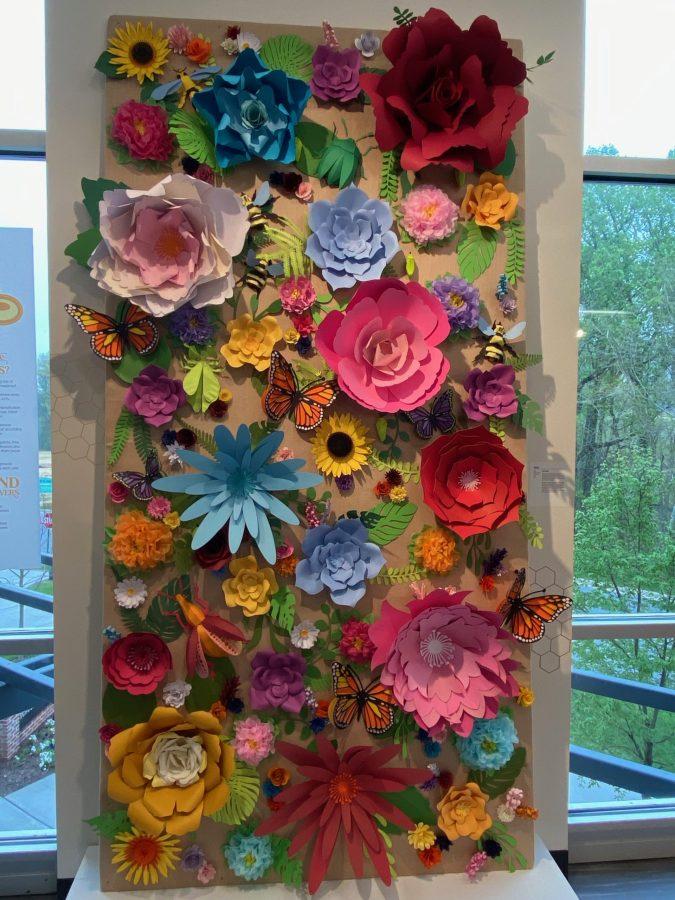By: Karli Banas
Colorful flowers, Barbie cars, and coloring pages are just a few features of the exhibit on the second floor of the Manning Academic Center. The exhibit displays the capstone projects of senior Graphic Design majors, who each created their own displays based on their passions.
A project called “Pollen.” by Angie Turner is an eye-catching display focused on saving bees. The project includes a wall of bright, colorful, three-dimensional flowers. The flowers have great shape and detail that makes them look realistic.
“Likewise” by Zoe Boehl transports the viewer to an early 2000s older sister’s bedroom. The display is complete with a leopard beanbag chair, fuzzy rug, and Spice Girls poster. Boehl has a magazine for millennials titled “Likewise,” which is what her project is based on. The display also includes small booklets that each have different cover designs, that are hung on strings, and a stole that has decorated legs.
At first glance “Genesis” by Ada Portillo may look like photos taken on an African safari, but all of the photos were actually taken locally. The project emphasizes the importance of nature in our lives and how different our lives would be if we spent more time away from technology and out in nature.
“I want viewers to stop, reflect, and think,” Portillo said. “Going out in nature more has allowed me to clear my head.”
Portillo feels technology has created new problems in its effort to solve other problems. She has seen people become addicted to being on their phones and feels we spend too much time looking at the false reality of social media. “My project focuses on how we might see truth through nature. I want my display to be a place where people can reflect on their own lives, rather than be told what to do.”
Kelli Garriott’s project “UCare,” looks a bit different from the rest of the exhibit. Her display includes a written story, a family photo, and a monitor. Garriott’s project is arguably the most personal in the exhibit.
“UCare” is designed to be an app to assist caregivers who are caring for loved ones with dementia. Garriott came up with the concept after watching her grandfather battle dementia and the effect it had on her family.
The app is designed to focus on the mental health of caregivers with features like inspirational quotes, a calendar, information on how to care-give, a way to communicate with family and friends, and a place for the caregiver to reflect on their own mental health.
“My family didn’t know about caregiving and dementia until we had to deal with it,” Garriott explained as her reasoning behind her project. Garriott was excited to be able to connect with others who had similar experiences at the opening reception for the exhibit.
In terms of what Garriott wants viewers to take away from her exhibit, she stated “I want people to reflect on their life and appreciate what they can remember.” Her display includes sheets of paper for viewers to write their reflections on and place into a box.
Rebecca Doyle’s “Bimboland” features early 2000s essentials like a dollhouse, a Barbie VW Bug, and a pink and purple tv. The project focuses on how feminism has evolved to be more inclusive and accepting. Doyle’s project included a book of photography that utilized different models and accessories to showcase the intersectionality of today’s feminism. By scanning a QR code, viewers can observe an amazing collection of digital collages made by other students, that are reminiscent of scrapbooks and Regina George’s Burn Book, complete with magazine cutouts, hand lettering, and glittery stickers, and rhinestones.
The inspiration for Doyle’s project came from “The recent resurgence of the early 2000s, and how women like Britney Spears and Janet Jackson have been actively reclaiming their stories.”
Doyle discovered the bimbo movement on Tik Tok and liked how it celebrated the empowerment of women, but was also inclusive to queer, trans, and non-binary individuals. Doyle chose to combine these themes with the idea of self-discovery.
“I think so much of the coming-of-age experience doesn’t just happen when you’re a teenager, it’s something that’s ongoing, especially in your early 20s,” Doyle said is something she learned during her college years.
She hopes her display inspires others to continue their self-discovery journey, no matter their age. She also hopes viewers feel connected to the nostalgia of her display, as most of the toys in the exhibit were her own when she was young.
The exhibit will be on display until June, so students are encouraged to check it out before leaving for the summer.






























































